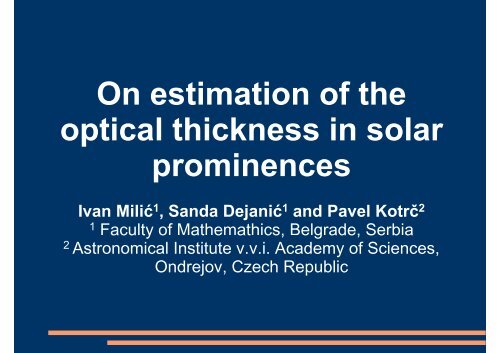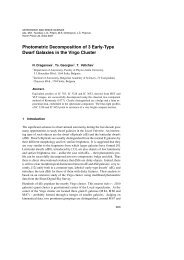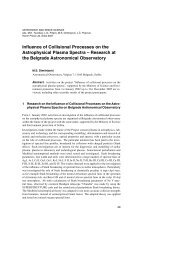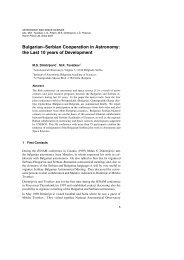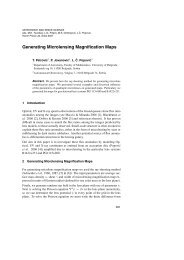On estimation of the i l hi k i l optical thickness in solar i prominences
On estimation of the i l hi k i l optical thickness in solar i prominences
On estimation of the i l hi k i l optical thickness in solar i prominences
You also want an ePaper? Increase the reach of your titles
YUMPU automatically turns print PDFs into web optimized ePapers that Google loves.
<strong>On</strong> <strong>estimation</strong> <strong>of</strong> <strong>the</strong><br />
<strong>optical</strong> t<strong>hi</strong>ckness <strong>in</strong> <strong>solar</strong><br />
prom<strong>in</strong>ences<br />
Ivan Milić 1 , Sanda Dejanić 1 and Pavel Kotrč 2<br />
1<br />
Faculty <strong>of</strong> Ma<strong>the</strong>mat<strong>hi</strong>cs, Belgrade, Serbia<br />
2<br />
Astronomical Institute v.v.i. Academy <strong>of</strong> Sciences,<br />
<strong>On</strong>drejov, Czech Republic
Introduction<br />
• Correlation between <strong>the</strong> opacity <strong>of</strong> a prom<strong>in</strong>ence<br />
and dits absorption <strong>in</strong> UV<br />
• Fast and reliable method to estimate <strong>the</strong> opacity <strong>of</strong><br />
prom<strong>in</strong>ences was needed<br />
• Method should deal with non-calibrated images
Method<br />
• Pr<strong>of</strong>ile <strong>of</strong> Hα emission l<strong>in</strong>e <strong>of</strong> a prom<strong>in</strong>ence, with<br />
some approximations i can be represented with<br />
function:<br />
I S e<br />
=<br />
λ<br />
2<br />
( λλ − max2<br />
)<br />
−<br />
2<br />
τ e<br />
∆λ<br />
(1 −<br />
d<br />
0 ⋅<br />
)
Method<br />
• Aim was to fit <strong>the</strong> observed pr<strong>of</strong>ile with t<strong>hi</strong>s<br />
function<br />
• Problem: Source function and <strong>optical</strong> t<strong>hi</strong>ckness are<br />
not <strong>in</strong>dependent<br />
• Solution: Use follow<strong>in</strong>g iterative method
Method<br />
• Assume some start<strong>in</strong>g <strong>optical</strong> t<strong>hi</strong>ckness<br />
• Calculate l S from <strong>the</strong> maximum <strong>of</strong> observed pr<strong>of</strong>ile<br />
• Among certa<strong>in</strong> number <strong>of</strong> values for τ, f<strong>in</strong>d one<br />
w<strong>hi</strong>ch fits best to our observed pr<strong>of</strong>ile<br />
• Make that value <strong>of</strong> τ new value <strong>of</strong> <strong>optical</strong><br />
t<strong>hi</strong>ckness<br />
• Repeat process until convergence
Results<br />
• 52 processed prom<strong>in</strong>ences, 188 l<strong>in</strong>e pr<strong>of</strong>iles<br />
• Optical t<strong>hi</strong>ckness goes between 0,97 and 1,57<br />
In one prom<strong>in</strong>ence <strong>optical</strong> t<strong>hi</strong>ckness measured <strong>in</strong><br />
• In one prom<strong>in</strong>ence, <strong>optical</strong> t<strong>hi</strong>ckness measured <strong>in</strong><br />
different spots rarely varies more <strong>the</strong>n 0,3.
Po<strong>in</strong>t<br />
1<br />
2<br />
3<br />
4<br />
5<br />
6<br />
7<br />
8<br />
No.<br />
τ 0<br />
1,27<br />
134 1,34<br />
124 1,24<br />
1,20<br />
133 1,33<br />
137 1,37<br />
123 1,23<br />
1,27
Conclusions and discussion
Thank you all ! ! !


